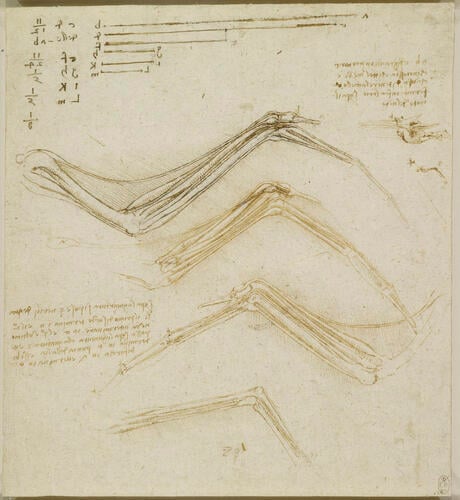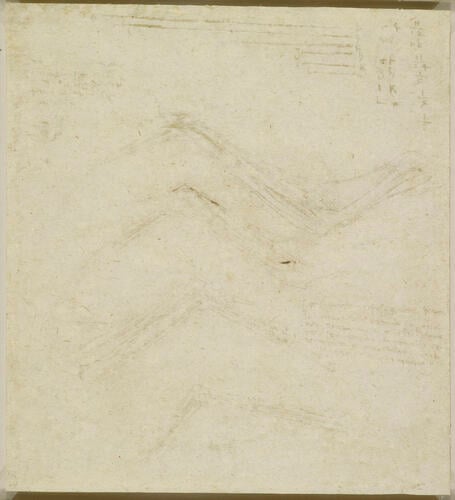-
1 of 253523 objects
The anatomy of a bird's wing c.1512
Black chalk, pen and ink | 22.2 x 20.4 cm (sheet of paper) | RCIN 912656
-
Four studies of the bones of a bird's wing, with notes on its construction; a small drawing of a bird flying, with notes on its action; lines bearing proportionate relationships to each other, and fractions expressing those relationships.
The first two anatomical studies here are dorsal views of a bird’s right wing. Projecting forwards from the carpometacarpus is the first digit, the alula; the second and third digits are fused to form the tip of the wing. Leonardo labelled the structure a b both in the upper anatomical study and in the sketch of a bird in flight in the right margin, noting ‘a b is of great importance because this part is the cause of keeping the bird steady in the air above the movement of the wind’. Elsewhere Leonardo called the alula ‘the rudder of the wing’, and it is indeed used for manoeuvring in slow flight; while he might have overstated its importance in normal flight, his appreciation of its aerodynamic role is highly impressive.
Curving from the shoulder to the wrist is the tendon of the patagialis longus muscle, which forms the leading edge of much of the wing. Running from the distal end of the humerus and inserting by long tendons on the carpometacarpus are three muscles (extensor carpi radialis, an unidentified extensor, and ulnaris lateralis).
The third drawing shows the same wing from below, with key letters and a note to clarify the insertions of these muscles: "Three tendons are placed over the joint. Of these the first [ulnaris lateralis] terminates underneath at n [on the carpometacarpus], the second tendon terminates at c [tip of the basal phalanx], and the third and last [extensor carpi radialis] passes over the joint s and ends at t, the tip of the wing."
These are not ‘thread diagrams’, as might first appear: a bird has relatively little muscle mass in the wings, for these muscles are used primarily for extending and retracting the (light) outer parts of the wing. The much larger muscle responsible for powering flight is pectoralis, the ‘breast’ muscle, originating on the keeled sternum; Leonardo has not indicated this muscle, or its tendon inserting on the humerus.
The lines at the top of the page are a proportional analysis of the different sections of the bird’s wing. In the absence of a scale, the species dissected by Leonardo cannot be identified, but the length of the ‘hand’ suggest that it was a bird capable of strong soaring flight such as a raptor.
Text adapted from M. Clayton and R. Philo, Leonardo da Vinci: Anatomist, London, 2012.Provenance
Bequeathed to Francesco Melzi; from whose heirs purchased by Pompeo Leoni, c.1582-90; Thomas Howard, 14th Earl of Arundel, by 1630; probably acquired by Charles II; Royal Collection by 1690
-
Creator(s)
Acquirer(s)
-
Medium and techniques
Black chalk, pen and ink
Measurements
22.2 x 20.4 cm (sheet of paper)
Category
Object type(s)
Other number(s)
Alternative title(s)
The bones and muscles of a bird's wing

